AN EXPERIMENTAL STUDY OF THE VALIDITY OF METAL-BENDING PHENOMENA
JOURNAL of the Society for Psychical Research
Volume 48 No. 770 December 1976
Introduction
During 1974-75, following the television appearances of Mr. Uri Geller, an increasing number of subjects, mostly children, reported the bending of metal objects by allegedly paranormal means. Our involvement (1) with investigation of these phenomena has enabled us to gain experience on the requirements necessary for validation of paranormality.
Metal can be bent by force produced physically (mechanically), or can bend spontaneously by the relaxation of internal stresses. If bending can be proved to have taken place and these causes can be precluded, then paranormal bending is validated. Since spontaneous bending is slight, validation might at first appear to be a simple physical problem of eliminating physical force. It still appears to us to be reasonably simple, but the psychological issues involved in the credibility are much more complex. In this paper we discuss the physical and psychological issues which have been encountered in our validation of these reports.
Most allegedly paranormal bending is achieved by the stroking action of the fingers and thumb of one hand; but there are alleged instances in which the metal is touched by no human hand at the moment of bending; and other alleged instances in which the metal is being held by a person other than the supposed subject.
One may also distinguish between the following reported events; gradual bending, taking about five seconds minimum, to about two hours maximum; sudden fracture of polycrystalline specimens or cleavage of crystals; and the rare plasticization of the metal, which is very difficult to validate.
The normal bending of a metal strip is brought about by loading, most simply the three point load, which produces a uniform cube-law curvature, and the four point load, in which the centre section is free from stretching force. When the loading (stress) is light, the deformation (strain) is elastic, and is proportional to the load. When the loading is increased beyond the yield, the deformation becomes plastic, that is to say, permanent rather than temporary. Deformation progresses until work-hardening prevents further motion. If the loading is sufficiently large, the work-hardening will be insufficient to prevent fracture.
Newtonian mechanics indicates that if bending is observed it must be accompanied by a force. Whether the bending is elastic or plastic, a physical detection of strain should be possible, as will be described below. It is possible that a normal internal stress already exists within a polycrystalline metal specimen which has been crystallized from a melt and rolled out into strip. This can be demonstrated either by milling the strip sufficiently thin, or by heating to a temperature close to the melting point; in either case small deformations (~5°) can occur. Annealing of a polycrystalline metal specimen, or the use of single crystals ensures the avoidance of these effects.
The subjects whose alleged metal-bending abilities have been witnessed vary greatly in their approach, and the effects produced also show variations. Our experience has been gained with ten children (6 boys, 4 girls), aged between 7 and 17, and with Uri Geller himself. The establishment of rapport with adult subjects was discussed in a previous paper (1), and the problem with children is similar, being partly a matter of establishing rapport with the parents, and partly of achieving good motivation of the child. Since the desire and ability to bend metal does not usually come on demand, the chance of observing phenomena is much larger in the subject’s home than if a visit is paid by the child to the investigator’s laboratory. The field work in the subject’s home can only be done if portable apparatus is prepared and if the conditions in the home are suitable. The requirements necessary for validation under discussion in this paper need not be jeopardised.
These requirements will be discussed under the headings of visual observation and video-tape recording, chart-recording of physical parameters, examination of specimens, “impossible” tasks, and brittle metals.
We also think it necessary to discuss briefly the methods of trickery by which paranormal bending might be simulated.
These can broadly be classified as the unobserved use of normal force, the weakening of the specimen until observed normal force produces bending, and the substitution of other specimens. An important principle of a conjuring trick is that the event precedes the observation. Thus, force can be used to bend a specimen when the attention of the observers is momentarily distracted. When the attention is re-focussed, the bent specimen is partially concealed in the hand, and gradually revealed, the movement of the fingers giving the illusion that bending is in progress.
A metal strip can readily be weakened by forcefully bending it to and fro a number of times. It takes practice to estimate the exact amount of bending required to weaken the strip sufficiently for the subsequent trick to be adroitly performed. The surface of a specimen which has been weakened in this way is usually visibly recognizable by cracks or otherwise. It can, however, be covered by holding between finger and thumb. If the specimen is then physically bent until it breaks, the fracture is indistinguishable from most fractures that have been produced allegedly paranormally. Other methods of weakening require tools, heat or chemicals, and the weakened section can be disguised with filling. These methods can readily be detected by subsequent examination of the specimen.
Witnessing by visual observation and videotape
recording
The object of witnessing by visual observation and videotape recording is to determine whether or not physical force has been entirely responsible for the bending, and to determine whether the specimen or any other object has been substituted at any moment.
Witnessing by visual observation is a deceptively simple exercise, which requires careful preparation and practice to perform well. The best number of witnesses is three or four; any more will introduce cross-currents which distract the attention; the field of view of each witness is also diminished. Fewer witnesses would certainly ensure that the field of view of each was very large, but probably larger than each could successfully watch. There should always be more than one witness, since the chances of catching a momentary sleight of hand are increased by using several. Attention should be paid to the lighting (shadows minimized), to the background surface, and to the avoidance of all distractions, whether originating from the subject, from the witnesses, or externally. The maximum time over which a really high standard of visual concentration can be maintained by a witness is about two to three minutes. If the event takes longer than this, then undoubtedly moments of lapsed concentration will occur, increasing in frequency as time proceeds, thereby increasing the probability that the concentration of all witnesses will lapse simultaneously.
An important consideration is the width of field of view which it is required to observe; it should not be larger than about 0.05 steradian, otherwise motions of the eyes become unsuitably large. With chart-recorded experiments this presents problems, since there are several widely separated points which must be simultaneously watched. But the witnessing of bending of a metal specimen held in the hand, or within inches of the hand, is much simpler, since all that is necessary is to concentrate very hard on a narrow field of view. A distance of about two to three feet between the witnesses’ eyes and the specimen enables the maximum detail to be recognized without widening the field of view unduly.
When a specimen is held and stroked between fingers and thumb, parts of the specimen are concealed from view by parts of the hand. This screening is minimized when the witnesses view from different angles and different heights. A three point load can most easily be applied to a specimen, using one hand, by (i) the ball of the thumb, (ii) the first or second joint of the forefinger, and (iii) the base of the palm. The bend will then be centred on the point of application of the forefinger. But if the specimen is only about two inches long (e.g. a latchkey), then it is not possible to apply a three point load in this way; instead, the thumb and two fingers would be used; in this operation, much more of the specimen is exposed to view. We have used latchkey specimens for this reason. On occasions it has been noticed that paranormal bending takes place beyond the end of the thumb and fingers, which would be impossible under normal bending from a physical three point load. When the bend is gradual, it is difficult to be certain that there is no physical three point load throughout the time of bend. But on one occasion a single crystal of zinc was stroked between the fingers and thumb by a ten-year-old boy, under good conditions of observation; an instantaneous cleavage was observed, beyond the end of the fingers and thumb. The end of the crystal dropped to the table, leaving the remainder of the crystal exposed, projecting beyond the fingers and thumb. A sudden event of this sort enables the witness to be certain that the position of cleavage is not within the two outer loading points, and therefore, that physical force of the fingers and thumb could not have caused the cleavage.
An important task of the witnesses is to ensure that the intended and identified specimen remains in view from the moment it leaves the possession of the investigator until the moment it is returned to him.
A controversial type of paranormal event which should be discussed is the alleged softening or plasticization of metal. The author has witnessed one such event with Uri Geller, under the following circumstances. A stainless steel teaspoon, previously bent through a small angle by a child subject, was offered to Geller as soon as he arrived in the laboratory. On his grasping it by one end, it immediately appeared to go soft and sag at the point of the previous bend. Geller now took the other end in his other hand, and bent the spoon to and fro. The author then took it from his hands and with a gentle action continued the to and fro motion for about thirty seconds.
This behaviour is different from that of a spoon which has been weakened and can only be bent to and fro a very limited number of times. We consider the witnessing of this event (by the author and two other witnesses) to have been good, but the evidence of several similar events is required before certainty of plasticization can be recorded. We can, however, be certain that the event looked quite different from the normal fracture of a weakened specimen. Its description is given here in order to illustrate the importance of the witness handling a specimen in such a condition.
A brief mention of witnessing by videotape must be made; its purpose is twofold: to obtain records by means of which a physical event can be studied repeatedly: and to obtain records to increase the credibility of the investigator. Although the achievement of each purpose is important, the temperamental nature of the metal-bending ability is such that some investigators do without the luxury of videotape recording for most of the time. It is important to assign the correct priority, as between experimentation and “film production”, and to maintain a suitable proportion of each. It is also a matter of experience that if the experimenter is also cameraman, then he cannot also perform adequately as witness. The technical operation – fields of view, lighting, panning, etc. – occupies most of
his time.
Chart records
Chart records of metal-bending events are useful both for validation and for study of the time dependence of bending phenomena. Internal stress may be measured by a microtransducer such as a resistive strain gauge, mounted inside the specimen. Since this will also register signals arising from muscular force, an embedded resistive strain gauge can only be used with the subject not touching the specimen. A suitable instrument built in our laboratory by Mr. N Nicola is detailed in Figure 1. A slot 9mm long x 1mm wide x 5mm deep is milled in a latchkey and the strain gauge fixed inside with epoxy resin; it should not lie on the neutral plane.
The attraction to the subject of this apparatus lies in the fascination of the chart-recorded signals which can readily be produced by bending the specimen elastically between the fingers. The sensitivity of the chart-recorder is adjusted so that such signals are seen to be of suitable size (Figure 2). Peaks produced by finger action are about one second in duration (a), which can be regarded as a time constant of application and relaxation of muscular force. Peaks produced by dropping of weights on the cantilevered specimen have rise time of about 50mili seconds (b,c), which is about the limit of resolution of the chart-recorder. After a weak application of force, the specimen returns to its previous configuration and stress (b), since the deformation is elastic, and much weaker than that required for plastic deformation. But after a sufficiently strong force, some permanent deformation is noticeable (c). The subject is asked to try to produce signals without touching the specimen; he is watched, but if a flat latchkey is resting on a flat surface, he would have to pick up the latchkey in order to exert a three point load.
Some examples of the stress signals produced, without touching the specimen, by subjects Andrew G (aged 11), David N (aged 9) and Richard B (aged 12) are also shown in Figure 2. It is apparent that the rise times of the peaks (e) are of the order of 200ms, much shorter than the rise times of those produced by muscular force. Thus to some extent the peaks are characteristic of the physical shock waves produced by knocking the specimen with a hard object. They are similar to, although weaker than, raps produced by mediums, but if they were obtained on a suitable sounding board or membrane only the strongest would be audible. Another type of stress transient (f), is one in which the metal, although untouched, is under stress for several seconds, and then returns to its previous unstressed condition.
A necessity in stress chart-recording experiments is that in the absence of the subject the chart should show a reasonably low level of noise, and no transients of magnitude at all comparable to those claimed to be produced paranormally by the subject. In the present apparatus the noise level was usually two to three orders of magnitude smaller than the signals, but in order to eliminate electrical transients battery operation is valuable; if ring mains electricity is used in a house, then the closing of other switches (such as that of the refrigerator thermostat) can cause transients. Attention must also be paid to the introduction of transients by electrostatic charge. A clear run, free from transients, of many minutes is necessary before the subject can be introduced. On occasion, quiet periods of several hours have been recorded before experimentation.
A complete record of the paranormal bending without touching of a latchkey, by Nicholas W. during a session of 2 hours, is shown in Figure 3. The latchkey was suspended by means of the electrical connections, so that touching by hand would cause it to swing to and fro. The absence of such motion, even during the final bending, is some evidence that the paranormal forces are primarily torque and not translational.
The stress signals were at first reluctant to appear, and because of their small magnitude on the chart recorder sensitivity range used in previous experiments (100mV), the sensitivity was increased by a factor of 10 (10mV), so that thermal and other noise became significant; the signals obtained were at first only a few times larger than noise. When the signals eventually increased in magnitude, the sensitivity was turned down by successive factors of ten (100mV, 1V, 10V); each time the signals continued to increase in magnitude to produce measurable permanent deformation of the latchkey. During the final period the latchkey was visibly bent, and the bending continued after the conclusion of the chart record paper. The bending angles, measured by careful handling and tracing onto paper, were then + 10° 1° at 18.06hr, + 50° 1° at 18.11 hr and + 12° 1° at 18.17 hr. The latchkey did not appear soft or fragile, and until the next experiment there was no further bending. The decrease in bending angle, although unexpected, is in keeping with the ambipolar transient behaviour in the final stages of recording. A photograph of the bent latchkey appears in Figure 7.
The visual witnessing of this experiment was not highly concentrated; in the early stages the steady trace of the chart recorder was deliberately not watched, so that tension should not develop in the subject. At no time, other than the manual tests, was the subject seen to handle the latchkey. However, during the chart recording he handled some items of cutlery, which bent into interesting shapes without apparent manual force being used.
A feature of these chart records is the great variety of strain transients that appear. They vary in magnitude and direction, in rise time, in decay time, in frequency of occurrence, and in fine structure. Considered from the point of view of validation, the variety is valuable, because of the corresponding variety of methods of production that is indicated.
A further programme of experiments on two simultaneously monitored specimens has been completed, and will be described in a further paper.
The method of simultaneous recording was also used by the author in an investigation of the effect of Uri Geller upon a nuclear radiation monitor (a Geiger counter). The output of a sensitive gaussmeter was chart-recorded at the same time as the output of the gamma-ray ratemeter, and simultaneous pulses (Figure 4) were recorded by the passage of an electric current in the Geiger counter screen; laboratory tests showed that this was a possible interpretation.
Examination of specimens
The primary purpose of examining a specimen is to identify it before and after bending, and to measure the magnitude of the bend. The most powerful simple identification is by accurate weighing; an accuracy of + 10^-4gm is readily available on a chemical balance. Apparently identical specimens exhibit different weights, even if only by a few tenths of a milligram. Considerable careful machining would be required to prepare specimens giving identical readings on the chemical balance. Weighing will also detect weakening by filing, chemical action, condensation of moisture and human sweat.
Various physical properties of the specimens might be considered as possible indicators of paranormal bending. They would only be valid indications if the structure of the metal were different, as between paranormal and physical bending. The orientation of grains in a polycrystalline specimen can be monitored by X-ray reflection; at our instigation in 1974 Barnes et al (2) made measurements on a brass latchkey allegedly paranormally bent by Geller, and found the data indistinguishable from the unbent parts of the latchkey. More recently some micro-hardness measurements have been made (3) on polycrystalline and single crystal specimens allegedly paranormally bent by our child subjects. The data (Figure 5) do not show appreciable differences from those for physical bending. Thus neither of these techniques is in general suitable for validation by examination; nor is it likely that other physical techniques would be more suitable, since it may be inferred that structurally the paranormally and physically bent specimens are usually very similar, if not identical. It is true that other techniques might penetrate further into the solid, but there is no reason to suppose that paranormal bending is primarily a surface phenomenon.
A most unexpected finding was made on a single crystal of molybdenum of extremely high purity (25 parts per million ferromagnetics), which was bent without touching by Geller under reasonably good witnessing conditions. On subsequent examination it was found to be slightly ferromagnetic. The specimen possessed a magnetic moment of about the same magnitude as a specimen of commercial molybdenum of similar size, and would thus be expected to contain about 8500 parts per million of ferromagnetics; however, neutron activation analysis (to destruction) showed the proportions to be not much larger than the original values, so that the results are inconsistent.
At the time of the paranormal bend the crystal had been resting on a steel plate, and it might be conjectured that impurities had transferred to the crystal from the steel plate. Whilst this may well be nothing more than a wild speculation, it indicates a possible line of enquiry: entry of trace impurities during alleged paranormal bending. Some witnessed bends have been obtained in zinc and copper crystals of high purity, and analysis for trace impurities is in progress.
Another possible technique of validation by specimen examination has been applied to fractures produced by paranormal action. Examination of the fracture surfaces by electron microscope might show anomalies absent in normal fractures. Barnes et al (2) studied electron micrographs of cutlery fractures allegedly paranormally; but although some features were found which would not be expected in normal fractures, the complications were such that recognition of a paranormal fracture from the electron micrographs was by no means certain. It was reported by Franklin (4) that electron micrographs of paranormally fractured stainless steel spoons were very similar to those of normal room temperature ductile fractures. But witnessed paranormal fractures of a stainless steel needle and of a platinum ring showed low temperature creep and, within tens of microns, localized melting. A strong case could be made for these observations being good validation, but no confirmation has yet been reported. It must be recognized that the study of fracture electron micrographs is a specialization in itself.
“Impossible” tasks
A validation method possessing great advantages is the setting of tasks which would be “impossible” without paranormal bending. The greatest advantage is that the need for close witnessing is obviated. No observer can be confident of his credibility as a witness, because of the mystique on this subject spread about by the conjuring fraternity.
An “impossible” task might, for example, be to produce a large bend in a metal specimen inside a sealed all-glass tube. Glass is the only material suitable, since, uniquely, the breakage and re-sealing of a glass tube would be recognizable by a variety of simple physical techniques. Sealing by adhesive such as epoxy resin is inadequate, since breakage with the minimum of damage is relatively easy, and re-sealing can be very difficult to detect or identify with certainty. There are refractory metals which could be used for the material of the sealed tube, but it is thought that subjects find it easiest to produce effects inside a transparent material.
Although more than a dozen specimens in sealed all-glass tubes have been offered to subjects, we know of no case in which a large bend has been produced in a specimen in such a tube. But when a small hole (from 2mm to 12mm diameter) is allowed in an all-glass globe, then specimens can be bent inside. It is then a purely technical matter to determine whether or not the bend could have been produced with the aid of tools in the time available. We have found that instrument mechanics can produce bends in surprisingly strong specimens with the aid of tools inserted through the hole in the globe. Thus although metal strips can be bent by a subject in such a globe, the validation is not always straightforward in these cases.
One particular type of specimen has been found most suitable with child subjects, namely, the common paperclip, usually made of nickel-plated steel. Since these are relatively easy to bend physically, they are likely to be also relatively easy to bend paranormally. A number of clips can be bent together into a ‘scrunch’, although physically it is difficult to get them to interlock tightly. This tightening or interlocking cannot be produced physically inside a glass globe containing a small hole, but it can be produced paranormally by child subjects under these circumstances; it is therefore good for the validation of the paranormal metal-bending ability of these subjects, and a separate paper has been written about one such case (5). An illustration of a globe containing a paperclip scrunch produced by Andrew G (which has not appeared previously) is given in Figure 6.
Brittle metals
The normal loading of a metal strip causes an elastic deformation proportional to the load, but beyond a certain ‘yield-point’, further deformation takes place, of a plastic or permanent character. The strip work-hardens as it deforms, so that its resistance to deformation increases with time, until it is often sufficiently large to resist the loading entirely; no further deformation then occurs. But if the resistance is insufficient to resist the loading, fracture then takes place. There exist many brittle metals in which the work-hardening is so slight that any plastic deformation terminates in fracture. Such metals will not bend plastically, except by ‘creep’, a process which is only appreciable at temperatures greater than one half of the absolute melting temperature. Thus low melting point brittle metals may be deformed by creep at room temperature, but cannot otherwise be deformed plastically just by the imposition of a load. An attempt to cause plastic deformation of a brittle material must involve a load which increases steadily with increasing time. Since it is virtually impossible to terminate a manual load suddenly during the very brief period when the material is plastically deformed, it will be virtually impossible to bend manually a suitably chosen specimen of brittle material, except in a long period of time during which creep occurs.
Creep is the deformation produced very slowly by the continuous application of a load. The rate at which deformation occurs is not constant; according to Andrade’s law, the deformation is proportional to the square root of the time for which the load is applied. Although the law is an incomplete description, we have verified it over a particular set of conditions for the eutectic alloy of bismuth, tin and cadmium (M.P. 103°C). At room temperature the loading of a 6mm x 8mm specimen, supported by two knife edges 10cm apart, with a 3.2kg load for 4.25 hr. produces a bend through 16° . A sudden application of 3.5kg under the same conditions fractures the specimen; careful application of manual force to a 12cm specimen can produce a bend of up to 10° per minute, before accidental fracture takes place. But a suitably dimensioned specimen of this alloy cannot be normally bent, without fracture, through a large angle in a time of the order of minutes. It can be normally fractured with the appearance of a bend at the break; even in boiling water the alloy is still brittle and fracture will occur. In order to produce normally a large angle bend without fracture, a special machine producing a time-varying strain would have to be constructed.
A suitable specimen of this alloy can be used for validation of paranormal bending without concentrated witnessing, since the continuous application of surreptitious force will almost inevitably cause fracture. Specimens 15cm length and 6 x 6mm and 6 x 8mm cross-sections have been bent allegedly paranormally without fracture by Andrew G and Nicholas W as follows: 135 ° in 10 min. 100° in 5 min. 67° in 3 min. 62° in 2 min. 40° in 10 min. 34° in 6 min. At one session Nicholas W placed four specimens in his coat pocket, and within five minutes all four had bent, through angles 111°, 135°, 160°, 170°. As with bends that have been produced by creep loading for several hours, there was essentially no work-hardening (in one case a rise from 19.9 V.P.N. to 20.8 V.P.N. was observed on the neutral axis, but no rise on the outside curved surface).
Credibility. Conclusions.
Validation without high credibility of the validator or validators is inadequate. The credibility of a validator is his own responsibility. Simple analysis leads to the following conclusions:
(i) Credibility is usually increased proportionately to the number of investigators, provided that the rapport between them is sufficiently close. Since a large number of investigators is inefficient’ particularly
for witnessing, compromise is necessary. In these studies guest investigators, invited on particular occasions, have played a valuable role.
(ii) Credibility is highest when the involvement of the validator is only moderate, for example, when he is a researcher specializing primarily not in parapsychology, but in another field of natural or social science. On the other hand, such people have less experience in the subtleties of psychological and parapsychological fraud.
(iii) Reliance can be placed on the motive of a researcher to maximise his credibility. It is therefore with reluctance that he reports an incredible event. To an inexperienced parapsychologist, all paranormal events are of similar incredibility, but after study of the literature, patterns emerge, so that degrees of incredibility can be established. One therefore might be tempted not to report the anomalous paranormal events in large proportion. Yielding to such temptation of course makes the pursuit of experimental science impossible; one therefore does not admit to yielding to it, one deceives oneself into actual disbelief of the evidence for the event. This contradiction has perhaps contributed to the sharp division of intellectuals into sceptics and believers.
The contradiction is overcome if one accepts the situation that one’s own credibility is relatively unimportant. It is worth reporting that, as a newcomer to psychical research, my initial recorded position was to the effect that “I would believe only the evidence of my own senses and experiments”. After little more than two years experience, I have now personally had the opportunity to work out some patterns and beliefs on the basis of this evidence. I have also studied the literature, and found that these patterns are sometimes similar to those previously reported. I have also learned to apply various criteria of credibility of witnesses, for example, that of assessing their ability to distinguish between observation and inference. But I am still very conscious of the temptation to maintain a high level of credibility and even to build it up as capital; and of the importance of resisting this temptation. I therefore report my belief that I have been able to validate the metal-bending (not the metal-softening) phenomenon on a number of occasions by visual witnessing, chart-recording, “impossible” tasks and brittle metals.
I am grateful to the Society for Psychical Research for financial
support of this research.
- B. Hasted
Birkbeck College, University of London
References
(1) J.B. Hasted, DJ. Bohm, E.W. Bastin and B. O’Regan, Nature 254, 470, 1975.
(2) P. Barnes, J.W. Jeffery, O. Bateman, T. Gare, T. Southern; Birkbeck College, University of London, private communication 1974.
(3) M. Desvaux. Electrical Research Association, Leatherhead. Private communication 197 5.
(4) W. Franklin, New Horizons 2, 8, 1975
(5) J.B. Hasted, A Method of validating metal-bending phenomena, submitted to J. Sci. Inst. 1975.
FIGURES
Figure 1.
Strain gauge circuit and mounting inside latchkey.
Note, the input impedance should be the same, looking into the positive or the negative input to the bridge amplifier. It is not in this preliminary circuit. This condition is necessary in order that noise from the bridge supply is not amplified; higher gains are thus obtainable.
It is also possible to work with narrow band bridge excitation.
Figure 2.
Chart records of strain transients produced in latchkey. (a) Series of weak elastic bends produced physically by adult fingers. (b) 50 gm weight dropped from 2cm height onto end of cantilevered key. (c) 175 gm weight dropped from 10cm height onto end of cantilevered key. (d) Bends produced by vigorous action of adult fingers. (e, f) Transients produced by subjects without touching key.
Figure 3.
Chart records of strain transients produced during the complete (1-5) history of bendings produced in a latchkey by Nicholas W on 15 January, 1976. Intervals free from signals are displayed as horizontal spaces, with durations in minutes.
Figure 3 Cont.
Parts of the chart-record of time variation of Count rate measured by a Mini Instruments radiation monitor probe held in both hands by Uri Geller. Part of a chart-record of the output of a Newport Instruments. gaussmeter probe, showing two 2 mG peaks simultaneous with c and d. Inset: schematic diagram of apparatus, key as follows: G, Geiger counter; R. Harwell 2000 series ratemeter; CR, chart-recorder; L, loudspeaker. The shaded part of the Geiger counter screen is of insulating material, through which electrical transients can reach the amplifier input.
Figure 5 & 6.
Micro-hardness (Vickers Hardness V. P. N. ) variation along outside surface of single crystal of copper. (a) Shows the variation along length of outside surface of principal bend produced by apparently gentle stroking action of ten year old boy. Bent crystal is shown above the data points so that these can readily be related to the location of the bend. Distances x(cm) are measured along the bent surface. The tip of the crystal, at the right, was bent by the gentle action of fourteen year old Julie K, about an axis perpendicular to that of the principal bend. The bent tip, viewed from two perpendicular directions, is also shown enlarged in (b), together with data points measured at distances x(mm) from the extremity.
Figure 5 & 6.
“Impossible” task; glass sphere, 131mm diameter, 8mm diameter hole, containing paperclip scrunch produced by eleven year old Andrew G. in about thirty minutes.
Figure 7.
Latchkey after paranormal strain transients illustrated in Figure 3. A slight bend, of 12°, is apparent.
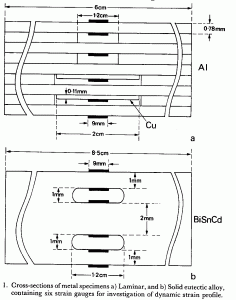 |
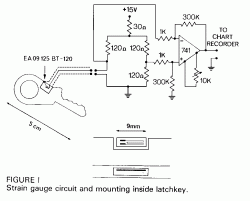 |
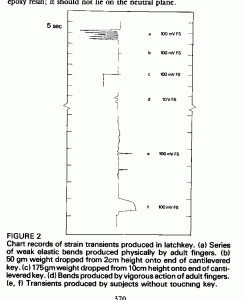 |
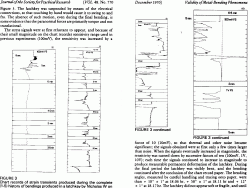 |
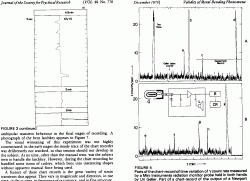 |
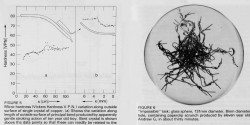 |
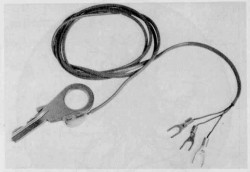 |


Latest Articles
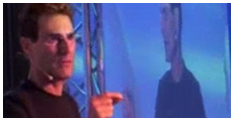
Motivational Inspirational Speaker
Motivational, inspirational, empowering compelling 'infotainment' which leaves the audience amazed, mesmerized, motivated, enthusiastic, revitalised and with a much improved positive mental attitude, state of mind & self-belief.



















